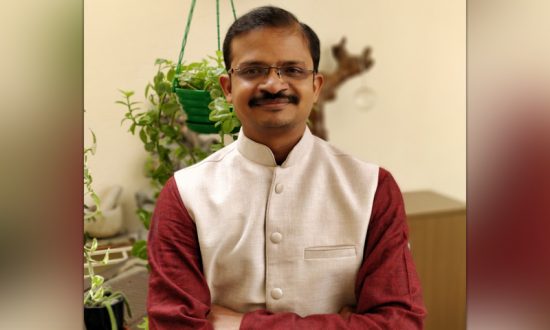Muralidhar Somisetty is a technology entrepreneur who co-founded a series of product start-ups in SaaS, Big-Data Analytics, IoT, Artificial Intelligence and Electric Mobility. Muralidhar is currently the Founder, Chairman & CEO of Wellnesys, an emerging deep-tech start-up recognized as one of the most innovative Top AI start-ups by TiE Silicon Valley and Established Co., YogiFi – an unique and innovative product idea that has come out of founder’s own life experiences as yoga practitioner/teacher has won the hearts of many people and received multiple global awards under innovation category.
In the new age of technology, the way we live, play, work and workout has dramatically changed. We have been witnessing an early onset age of the heart disease, anxiety and depression due to unhealthy lifestyle and modern-day stress. Pandemic has reinforced the importance of physical and mental health and necessity for holistic wellbeing.
Yoga has been among the top-10 most widely searched topic on Google in 2020 (pandemic waves), which naturally has now become part of doctor’s prescription for preventive healthcare. In the fast-paced life, yoga helps one relax their mind, body, and spirit. Yoga stood the test of time over generations and is continuously evolving to keep up date with modern lifestyle disease prevention and thanks to countless number of testimonials from people who benefitted with the practice to reverse their health issues.
Advent of smartphones with apps has opened the door for everyone to experience a great yoga workout while enjoying the comfort and safety at home. This has led to the surge in demand for online yoga with content and apps mushrooming everywhere. Meeting apps such as Zoom, Meet and Webex which were intended for only business meetings, have turned into a digital platform for online yoga classes. To some extent these platforms have been successful in enabling yoga teachers to conduct virtual classes with students across the globe and helped in raising visibility of quality teachers who can deliver authentic content from India, the land of yoga to the west.
Although the demand for yoga content and teachers has been overwhelming, online class experience could not really match up to the expectations of people who are used to the in-person physical studio experience has led to the churn in users / subscription as the sessions were found to be non-interactive, non-personalized and not effective in meeting individual’s fitness/wellness goals which would yield results only with consistent daily practice and motivation.
Above challenges with the existing solutions can be addressed by leveraging cutting-edge advanced technologies specifically Sensors, Wearables, Internet-of-Things (IoT) and Artificial Intelligence (AI), Augmented/Virtual Reality (AR/VR) etc.,
Like all other industry verticals, healthcare and more specifically, sports and fitness tech startups have adopted advanced technologies to improve health, maximize individual’s potential and thereby towards the betterment of the society.
Besides yoga apps and wearables, let us check how various innovations are promoting the ancient practice by unifying with modern systems to deliver a holistic wellness studio experience straight to individual’s home with comfort and safety.
Near-body wearables
Smart Yoga Mats
Yoga mats with sensors embedded and powered by artificial intelligence seems to be of greatest interest to yoga learners, practitioners, or even expert trainers. A smart yoga mat paired with a companion mobile app and an optional wearable device (Apple Watch, Fitbit etc.,) is a powerful combination in crafting a personalized yoga journey based on individual’s goals, their physical limitations, and any other constraints. Smart yoga mat acts like an instructor always on-the-go, provides real-time feedback on the posture alignment, with pre/post session analysis, recommendations for posture training by AI system enabled by trainer’s tips for an individual to reach perfection through posture training. One can even track their daily stats, have fun with virtual community leaderboard and share progress with their peers, friends and family.
On-body Wearables
Smart Watches
Makers of smart watches have been showing specific interest to introduce “Yoga” workout tracker apps in their smart watch, collecting basic movements, besides collecting vital information – heartrate , calories etc.,
Smart Clothing
Yoga apparel is the new gear with sensors embedded inside the clothing for interactive feedback on posture alignment. Wearables like these are designed to operate when paired with an app that receives and interprets the data on your smartphone or tablet. That is correct! Rather than putting sensors into apparel, such as yoga pants, shirts, and even shoe inserts, these clothes receive and translate data from sensors and pair that information with an app on your smartphone or tablet.
Computer Vision : Smartphone Apps
A few apps have moved from being content-centric to technology-centric, providing posture analysis using computer vision algorithms by leveraging the feed from the camera of smartphones.
Computer Vision : Smart TV Apps
Think about doing yoga in front of a television, following the teacher perform a complex asana broken down into multiple steps and Smart TV app can track and enable you to learn and practice or having a fun yoga challenge with your friend on other side, with computer vision making an assessment of each individual and pick the better yogi with a badge. Imagine the same in a large class with teacher now suddenly having the ability to remotely monitor the practice of students without a need for teacher to constantly monitor every one’s camera feed.
In summary, all the technology solutions are geared towards addressing the growing need and demand of fitness and health-conscious consumers, meet their wellness goals, enhance their health and wellbeing, providing an intelligent platform to learn and maximize one’s potential, by integrating workout routine into everyone’s daily lifestyle, measure effectiveness of sessions towards individual goals, specifically useful for remote therapy applications.The technology solutions should also be designed such that they augment teacher’s intelligence and help them to effectively guide practitioners virtually, track their student’s progress and help them to scale and provide personalized attention.


